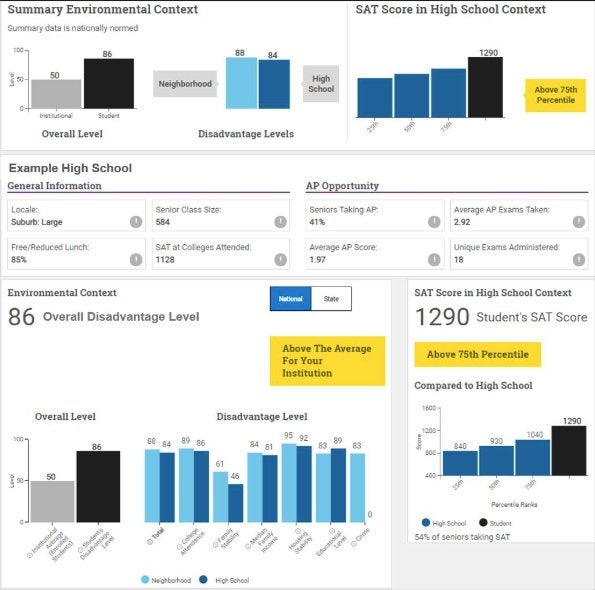When it comes to applying to colleges, students are largely evaluated based on a multitude of numbers: grade point average, class grades, class ranking and standardized test scores. But now, students might be judged by yet another number as the College Board add another score to the SAT: the adversity score.
The College Board, which administers the SAT college exam, plans to implement a new yardstick it calls the “Environmental Context Dashboard,” which is being widely referred to as the adversity score. The system, which has used by about 50 colleges and universities, will be expanded to 150 colleges starting this fall, and the new system will be made available to all colleges in 2020, Inside Higher Ed reports.
But what exactly will this new score accomplish?
According to The Wall Street Journal, this new metric is designed to capture students’ socioeconomic status and to give context to the SAT score. The College Board is utilizing a variety of environmental factors that may affect a student’s school and home life, including neighborhood crime rates, poverty levels, housing values, median family income and the communities average level of academic attainment, to determine a student’s “resourcefulness to overcome challenges and achieve more with less,” according to David Coleman, CEO of the College Board.

The score does not take race into account but does look at factors like the student’s high school’s average senior class size, the percentage of students eligible for free and reduced-cost lunches, and academic achievement in Advanced Placement classes, CNN reports.
“This is a tool designed for admission officers to view a student’s academic accomplishment in the context of where they live and learn,” a spokeswoman for the College Board said.
To calculate the score, students will be scored on a scale of 1 to 100 based on records such as the U.S. Census and the National Center for Education Statistics, The Atlantic reports. Scores above 50 indicate that a student has had to navigate more obstacles that the average student to attain an education and to have access to college, whereas scores that are below 50 show that a student has had more opportunities than their peers.
While students won’t actually know their score, college admissions officers will be able to see an “environmental context dashboard,” which breaks down all the factors that have gone into the score.
According to Connie Betterton, a College Board vice president who has led the team in developing the new scoring system, says the team has been working on this for the past three to four years, with a number of college admissions offices telling the College Board what sort of information they felt would be most beneficial for their offices to have.
SAT to begin assigning “adversity score” to students including social, economic background info https://t.co/KoriMYmoF4 pic.twitter.com/iJuSXQt90g
— The Hill (@thehill) May 16, 2019
When developing the score, the team found that admissions offices were most concerned about the talent they weren’t seeing, particularly students who might thrive on their college campuses but may have had weaker academic transcripts, Coleman told The Atlantic.
“What these years were spent on was examining if the data [on poverty and disadvantage] was looked at together in a really clear way with the SAT, could it help admissions officers find kids they wouldn’t have seen? And do those students go on to flourish?” Coleman said. “And the evidence is that they do succeed, that they are resourceful.”
For colleges who participated in a pilot program of the new score, including Yale and Florida State University, applicants from “higher levels of disadvantage were more likely to be admitted, suggesting that the additional context influenced admissions outcomes,” according to the College Board.
While this new system does not alter a student’s SAT score, it shows how a student compares to other students at the school but does not include any sort of personal characteristics.
Pace University President Marvin Krislov believes the adversity score tells only part of a student’s story.
“It won’t let admissions officers know if the student has overcome a major disability or illness,” Krislov said in a statement. “Or if the student has experienced a significant loss. But it can be a useful new factor in a holistic admissions review.”
But this new system marks a shift in how the College Board wants college admissions offices to think of its SAT scores, which have largely been criticized as a measurement of wealth and privilege, not intellect, as higher test scores correlate with higher family income and education levels, according to The Washington Post.
While this new score can’t solve all of these inequities, proponents of the new score say that it is a step in the right direction.
“You might see a student’s score and think, not bad but clearly below our university average. But then when you compare it to the school, it might be above the 75 percentile, which means they outperformed most people at their school,” John Barnhill, Florida State University’s Assistant Vice President for Academic Affairs, said. “I believe this context is a more accurate reflection of what the score represents.”
Anthony Abraham Jack, a Harvard professor and the author of The Privileged Poor: How Elite Colleges Are Failing Disadvantaged Students, told The Atlantic, “It is giving us a look at how poverty and inequality directly affect students’ college destinations, as it relates to [test scores]. When students sit down [to take] the SAT, that doesn’t mean that everybody’s at the same starting line.”
Critics, however, feel the new score demonstrates the shortcomings of the SAT.
“Test-makers long claimed that their products were a ‘common yardstick’ for comparing applicants from a wide range of schools,” Robert Schaeffer, Public Education Director of the National Center for Fair and Open Testing, said in a statement.
“This latest initiative concedes that the SAT is really a measure of ‘accumulated advantage’ which should not be used without an understanding of a student’s community and family background,” he added.
According to the statement, more than 1,000 accredited colleges and universities have already opted out of using SAT or ACT scores in their admissions decisions.
“Is it fair that the College Board, the group that has designed a test that has proven to be unfair and biased towards black and Hispanic students and those from low income backgrounds, is now telling everyone that they have a secret score that somehow mitigates the discrimination?” a blog post by Top Tier Admissions said. “Is it fair that the College Board penalize students who happen to live in affluent areas and attend good schools, especially those schools that don’t offer AP courses?”
But for Coleman, the results — more colleges admitting these students that might have otherwise been unseen — are what matter most.
“We are beginning to help admissions officers find talent that was previously unseen to them, because that was the originating mission of the College Board,” Coleman said. “And I think the College Board is trying to take seriously the claim that SAT scores alone don’t do that. But seen in context, they could be powerful.”


